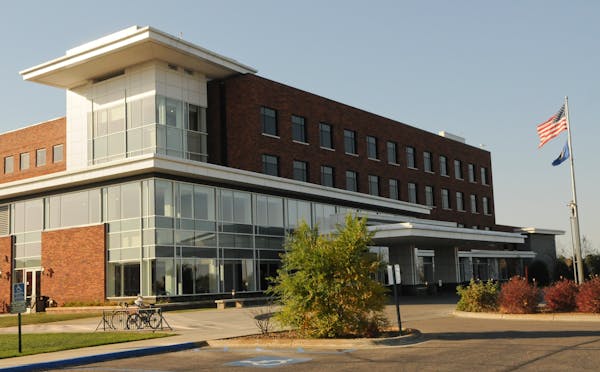The latest solution to chronic overcrowding of Minnesota emergency rooms was built in Wisconsin, delivered by truck to Maplewood and attached to St. John's Hospital.
The Short-Stay Observation Unit was unveiled Thursday to provide faster care to patients who often wait for hours or receive emergency treatment in hallways or lobbies.
The 16-bed unit will open Monday and specialize in patients who need a day or two of tests rather than prolonged hospitalizations and treatment, said Dr. Will Nicholson, vice president of medical affairs for M Health Fairview's East Metro hospitals.
Those patients can clog up hospital space because they wait in ERs for testing and end up getting admitted to inpatient beds intended for sicker patients, he said. "It's all about exactly what the patients need, exactly when they need it. That pushed us to look differently at our space and how we're going to build things."
Hospital leaders had hoped that pressure on their ERs would ease after the pandemic — and return to the old, manageable waves of flu infections in the winter and accidents and injuries in the summer. Instead, patient demand has increased by as much as 10% per year at most metro-area hospitals and at some rural Minnesota hospitals.
United Hospital's ER in St. Paul treated 5,500 patients in December, the busiest month it has ever recorded. The month was a convergence of COVID-19, flu, opioid overdoses, psychiatric crises, heart attacks and other conditions that are common to an aging population, said Dr. Kelsey Echols, the ER's medical director.
United Hospital's nearly empty waiting room Wednesday morning was deceptive, because more than half of the beds inside the ER were full with so-called "boarding" patients who couldn't be transferred to inpatient beds because none was open. When new patients arrived in the afternoon with urgent but not life-threatening problems, they had to wait for ER space to open up.
"I'm not sure the public is aware of how much strain the ERs are under," Echols said.
Nursing homes with post-hospital rehab programs have closed or contracted in Minnesota in recent years, leaving hospitals stuck with patients who can't be discharged until they have access to those services. Hospital leaders said they expect the backlog to continue even if new rehab options emerge, because Minnesota's aging population will have more medical needs in the coming decades.
Allina Health's Mercy Hospital ER in Coon Rapids has responded to persistent overcrowding by treating patients in hallways and waiting areas, which now have assigned names to reduce confusion.
United added a "fast-track" unit in its ER in 2017 to hasten treatment of less severe problems such as wrist sprains or pink-eye, but leaders of the Allina hospital are discussing a "super-track" unit where patients in need of simple tests or evaluations could receive them quickly and then wait for results, Echols said.
St. John's shares the same challenges as other hospitals, including the nurse staffing shortages since the pandemic that have prevented them from opening all their beds to patients. But the 1980s-era hospital also lacks the wide-open designs and space of more modern or renovated medical facilities.
The addition of its own fast-track unit helped last year, but patients still sat in every corner of the St. John's ER waiting room Wednesday afternoon.
On-site construction of the new short-stay unit would have taken a year or two and disrupted hospital operations, said Danielle Gathje, vice president of operations for M Health Fairview's East Metro hospitals. Instead, the health system hired The Boldt Company to build 90% of the facility in Appleton, Wis.
Trucks brought the unit last fall in 16 pieces that were then linked together at the hospital. Construction finished in a rapid 10 months, Gathje said.
Short-stay treatment already is happening out of necessity in the St. John's ER, where caregivers try to hasten patient care by ordering tests and treatments that usually occur on inpatient floors. Moving these patients to the new unit should free up ER beds and reduce wait times, Nicholson said.
The expansion will buy time, but Nicholson of M Health Fairview said hospitals need help from clinics and outpatient providers to address the expanding medical needs of an aging population. Patients struggle to make timely appointments with family doctors, especially if they have health problems at night or on weekends, which result in mild flare-ups of conditions such as congestive heart failure becoming major problems.
"If you can't get them in at the first sign of their [heart failure] exacerbation, and you wait an extra week or five days or whatever, a preventable thing becomes an emergency," he said.

Want to share info with the Star Tribune? How to do it securely

'Safe recovery sites' would offer syringes, naloxone and more to people using drugs. The plan could be in peril.
New Minnesota GOP leaders seek peace with party's anti-establishment wing

Who is Republican Lisa Demuth, Minnesota's first House speaker of color?

